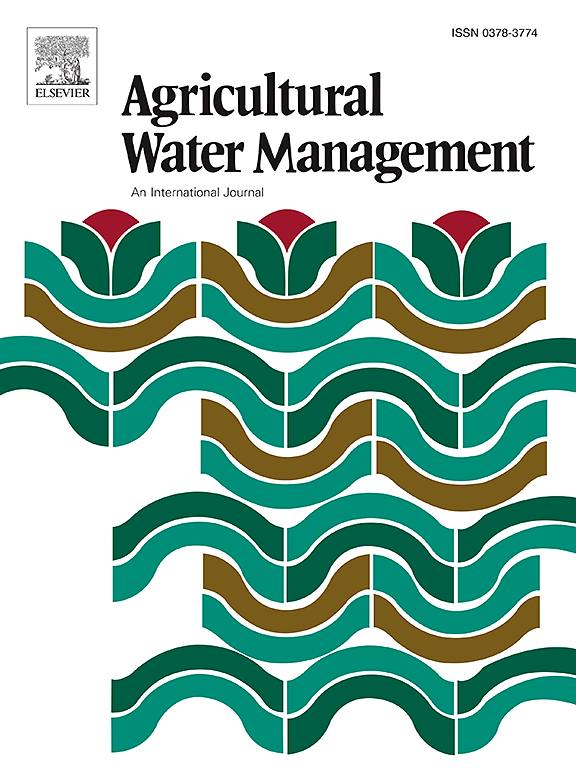Saline water concentration determines the reduction pathway for oat phosphorus absorption
IF 6.5
1区 农林科学
Q1 AGRONOMY
引用次数: 0
Abstract
Saline water irrigation offers a potential solution for sustaining crop yields under freshwater scarcity. However, it carries risks such as soil structure deterioration and soil organic matter decomposition, which could accelerate nutrient release. Elevated soil salinity further hampers crop growth and reduces nutrient uptake, particularly affecting phosphorus absorption. This study investigated the dynamics of soil pH, electrical conductivity, water content and available phosphorus throughout the entire growth period of oat treated with 1, 3, and 5 g L−1 saline water. It also examined the post-harvest responses of soil aggregates and their associated phosphorus, as well as the above-ground biomass and phosphorus content in various oat organs. The results showed that 1) Compared to the 1 g L−1, 3 and 5 g L−1 treatments significantly increased soil electrical conductivity and water content throughout most of the growth period, with the 5 g L−1 treatment also significantly increasing soil available phosphorus content; 2) The 3 and 5 g L−1 treatments significantly reduced the soil macro-aggregate (>1 mm) proportion by 24.76 % and 36.36 % (p < 0.05), while increasing soil micro-aggregate (<0.053 mm) by 39.41 % and 71.59 % (p < 0.05), along with higher available phosphorus content in the < 0.053 mm fraction; 3) The above-ground phosphorus content in oats decreased by 30.27 % and 35.39 % under the 3 and 5 g L−1 treatments, respectively, compared to the 1 g L−1 treatment. Partial least squares structural equation modeling revealed the different reduction pathways: 3 g L−1 saline water inhibited crop phosphorus absorption by reducing phosphorus concentrations in stem and shell (Path coefficient [PC] = 0.796, p < 0.001), whereas 5 g L−1 reduced it by decreasing the stem and seed biomass (Path coefficient [PC] = 0.816, p < 0.001). This study reveals the effects of saline water irrigation on soil and crop phosphorus availability, providing valuable insights for optimizing saline water use and enhancing phosphorus availability in agricultural systems.
盐水浓度决定了燕麦吸收磷的还原途径
在淡水短缺的情况下,盐水灌溉为维持作物产量提供了一个潜在的解决方案。但也存在土壤结构恶化、土壤有机质分解等风险,可能加速养分释放。土壤盐分升高进一步阻碍作物生长,减少养分吸收,特别是影响磷的吸收。研究了1、3和5 g L−1盐水处理燕麦整个生育期土壤pH、电导率、含水量和速效磷的动态变化。研究了收获后土壤团聚体及其相关磷的响应,以及燕麦各器官的地上生物量和磷含量。结果表明:1)与1 g L−1处理相比,3和5 g L−1处理在大部分生育期显著提高了土壤电导率和含水量,5 g L−1处理也显著提高了土壤有效磷含量;2) 3和5 g L−1治疗显著降低土壤macro-aggregate(在1 毫米)24.76 % 36.36 %比例(p & lt; 0.05),同时增加土、石灰(& lt; 0.053 毫米)39.41 % 71.59 % (p & lt; 0.05),以及更高的磷含量可用& lt; 0.053 毫米分数;3)与1 g L−1处理相比,3和5 g L−1处理燕麦地上部磷含量分别降低了30.27 %和35.39 %。偏最小二乘结构方程模型揭示了不同的还原途径:3 g L−1盐碱水通过降低茎和壳中磷浓度抑制作物磷吸收(通径系数[PC] = 0.796, p <; 0.001),而5 g L−1通过降低茎和种子生物量抑制作物磷吸收(通径系数[PC] = 0.816, p <; 0.001)。本研究揭示了盐碱水灌溉对土壤和作物磷有效性的影响,为优化盐碱水利用和提高农业系统磷有效性提供了有价值的见解。
本文章由计算机程序翻译,如有差异,请以英文原文为准。
求助全文
约1分钟内获得全文
求助全文
来源期刊

Agricultural Water Management
农林科学-农艺学
CiteScore
12.10
自引率
14.90%
发文量
648
审稿时长
4.9 months
期刊介绍:
Agricultural Water Management publishes papers of international significance relating to the science, economics, and policy of agricultural water management. In all cases, manuscripts must address implications and provide insight regarding agricultural water management.
 求助内容:
求助内容: 应助结果提醒方式:
应助结果提醒方式:


